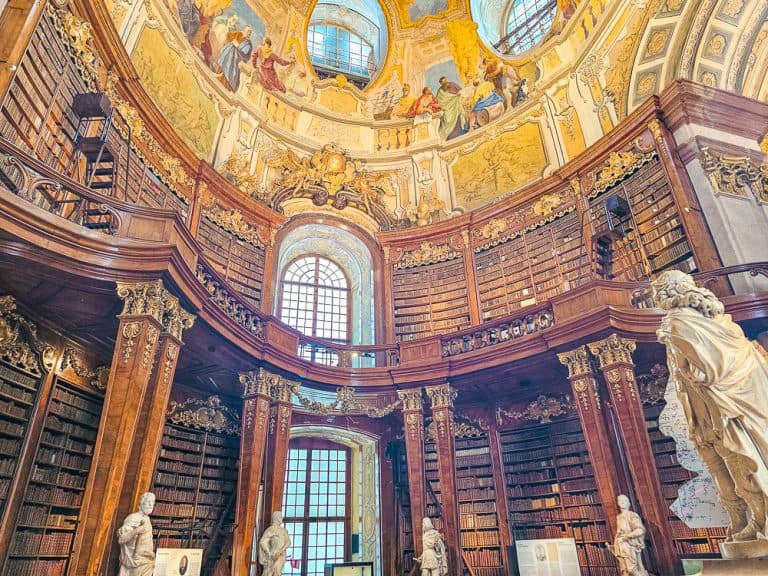This Colonial Gem Might Be the Most Photogenic City in South America
This historic, colonial city feels like one gorgeous, picture-perfect spot followed by another. The buildings are splashed with color – red, gold, pink, and blue everywhere. Vines, bushes, flowers, and bougainvillea wind their way up and around the buildings.
Welcome to Cartagena, Colombia, the beautiful port city on the north coast of South America. The city feels like a step back in time to colonial days, with interesting colonial architecture everywhere: massive, ornate churches, unique door knockers, rooftop terraces, and elaborate balconies and doors.
Suffice it to say, my jaw was just constantly on the ground walking around in Cartagena. We loved exploring this vibrant city.
Despite being a smaller city, there are a ton of things to do in Cartagena, and in the area nearby. You could stay for a long time in this Caribbean paradise, wandering the streets and exploring all her hidden corners. Read on for some of our favorite things to do and see!

Beautiful and Unique Things to Do in Cartagena
1. Explore the Walled City

The historic part of Cartagena is known as the Old City or the Walled City, as it is literally walled in. The Walled City is truly adorable streets everywhere and wandering the streets and taking in the beauty is one of the first things you must do in the city
Of course, during the daytime hours, there are also a lot of people and a whole lot of vendors on the street. Be prepared for people to be offering their wares to you constantly. The people of Colombia are very nice, though, and they will generally move along without further pushing if you just shake your head, or say “no gracias.”
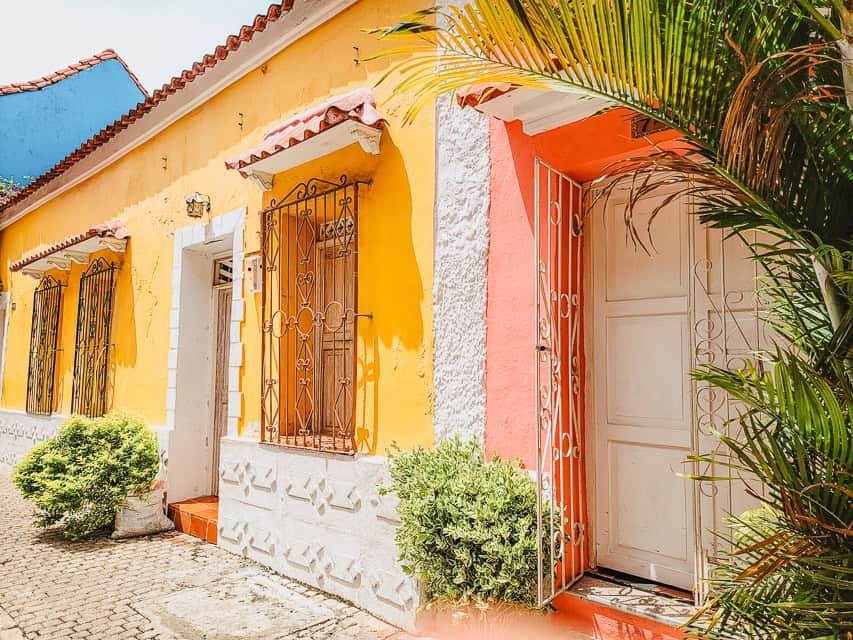
I actually would highly recommend waking up early at least one day to wander the streets when they are mostly empty of other pedestrians and any vendors. The sun rises around 6 a.m. year round and the city doesn’t really come to life before 8:30 or 9 a.m. Those hours in-between are magical.
Of course, come back later in the day when the churches, museums, shops, and restaurants are open, and to participate in the hustle and bustle of the city. Both experiences are good!
2. Clock Tower and the City Gate
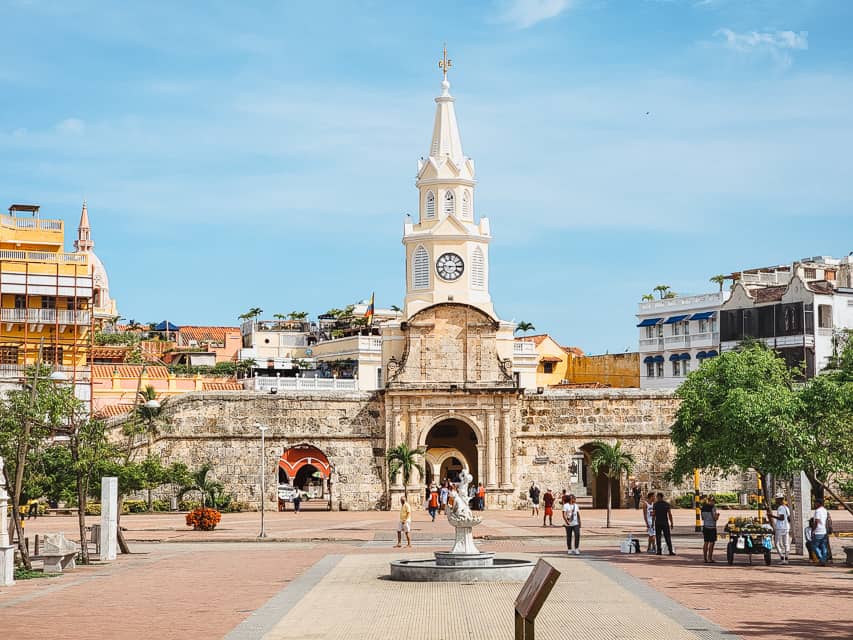
The Clock Tower (or Torre del Reloj) is part of the main city gate leading into the walled city. It’s a must-see during your visit to Cartagena!


There’s a large plaza in front of the gate (Plaza del Reloj) and inside the gate (Plaza de Los Coches). This is a beautiful monument and entrance to the city.
3. Walk Along the City Wall

As mentioned above, the old town of Cartagena is a walled city, and walking along the wall is one of the best things to do in Cartagena at any time of day, but it is for sure a top place to visit in Cartagena at sunset.
The west section of the city and wall look out over the sea making for a great view as evening falls.
Cafe Del Mar is the super popular spot for drinks at sunset along the wall, but you absolutely do NOT need to go here for a great sunset experience.
There are plenty of spaces along the wall where you get the same view with way less people, and if you want a drink, there are guys with coolers everywhere selling water, beers, and juice. (“Agua! Agua, cerveza, agua!”)
You can walk around the wall along almost the entire city. At different spots you can find cannons, little turrets, and peepholes out to sea.


Quick Tip: One of our favorite spots on the City Wall was up the ramp to the east (right) of the Bovedas market (See #20 on this list, below). The ramp will take you up to the wall and to a fun section with a tunnel and a jetty, an extra fortification that extends out from the wall. If you like castle fortifications, this is a small but fun spot to hit.
4. Explore the Plazas


There are over 13 plazas and squares in Cartagena, each one with a different vibe and tone. Often there will be stands selling drinks or snacks around the square, and sometimes there will be music or performances, especially in the afternoon and evening.
While you can just wander Cartagena and see what squares you stumble onto, these were a few of our favorites:

Plaza de la Aduana: A calm, people-free square just around the corner from Torre del Reloj.
Plaza San Pedro Claver: Right in front of the Sanctuary of San Pedro, this plaza has some quirky metal “sculptures” that we thought we kind of fun.
Plaza de Bolivar: One of the main plazas in town, which boasts a sculpture of Simon Bolivar. There are lots of benches to sit on and shade trees. This is where we saw dancers one time!
Plaza de Los Estudiantes: Right next to a pretty college building and with some trees. I just thought this one was pretty.
Plaza Cervantes: This plaza is just across the street from the Torre del Reloj city gate, has a few monuments, borders the Pegasus Dock, and a great vantage point of the gate. You can see a picture of this plaza in the #4 Clocktower section above.

5. Explore Getsmani Neighborhood
Getsmani is a charming neighborhood just outside the walled city. It’s filled with hip cafes, backpacker hostels, street art and murals, so many colorful buildings, and bougainvillea plants and flowers.


You’ll also see many streets with banners, flags, or umbrellas overhanging the street. In general, it is a bit more of a grungier neighborhood, but there is a lot of charm here too!


The area isn’t big, so with only a couple of hours you can explore the entire neighborhood and hit the highlights even faster.


These were some of our favorite streets in Getsmani:
- Carrera 10c
- Carrera 9
- Calle de la Magdalena
- Calle 29 east of the church
6. Participate in a Traditional Cooking Class
Cooking classes are quickly becoming one of my favorite activities to do in a new country, and this class was so fun! It was set in the kitchen of a local restaurant, but in a separate, smaller kitchen dedicated for the cooking class.
The class is done in English, with two instructors. You do two hours of cooking, where you prepare a full meal together. When we went, we made coconut rice (including making the coconut milk from scratch!), patacones, empanadas, sugar cane juice, and a whole red snapper.


The instructors were really fun and playful, the instructions and tips were really interesting, and it was fun to learn and see the process of how to make these very traditional Colombian foods. The time passed quickly!
This experience is also really nice because it starts mid-afternoon, after you’ve been in the heat for a long time and are ready for a break. It’s nice to come inside to the strong AC (hallelujah) and do some cooking in a fun, relaxed environment.
Once the meal is prepared, you sit down together in the restaurant to eat it, and I kid you not when I say it was one of THE most delicious meals of our entire time in Cartegena.
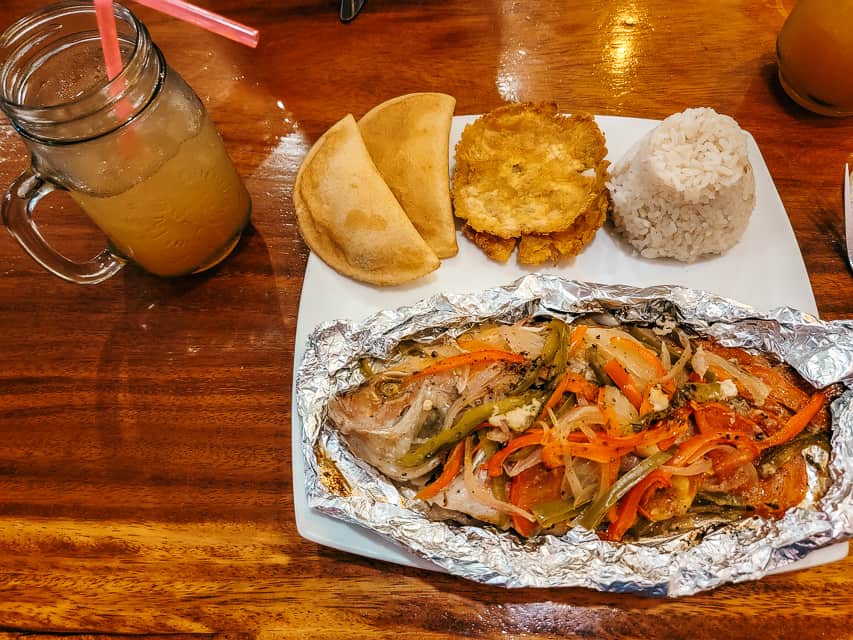
The rice was flavorful, the fish was so tender and flaky and moist, the patacones were crispy, the empanadas were savory, and the sugar cane lemonade was some of the best we had here in Colombia.
I loved this cooking class – it was truly one of my favorite experiences in Cartagena, and certainly one of the best places to eat in Cartagena.
Check rates and availability for this Colombia cooking class here
7. Do a Fun Vacation Photoshoot

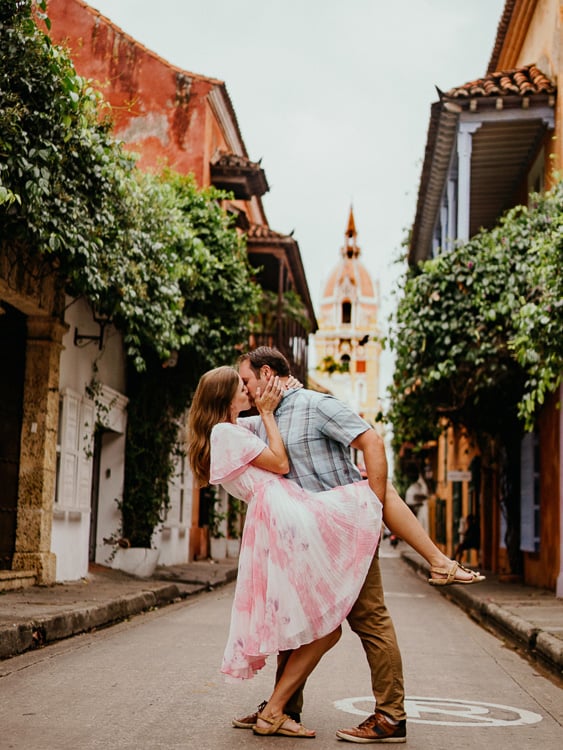
Doing a professional photoshoot is one of my favorite things to do on any vacation, and definitely a great choice for Cartagena.
While we take pretty good pictures by ourselves, there’s nothing like having a real professional to capture romantic moments with your partner, or candid, fun moments with your family or friends.
Plus, with the colorful buildings, fun architecture, and blooming flowers, Cartagena is the perfect setting for a photoshoot.



We did a shoot with July and Gilbert and they were the nicest, sweetest, photographer couple. They took absolutely gorgeous photos of us (all of the pictures in this section are from that shoot!) and were so chill and easy to work with and gave us lots of help with posing and photo ideas.
I know a photoshoot isn’t for everyone, but if you’re interested in doing a photoshoot during your visit to Cartagena, I can’t recommend July and Gilbert enough.
8. Catedral de Santa Catalina de Alejandria
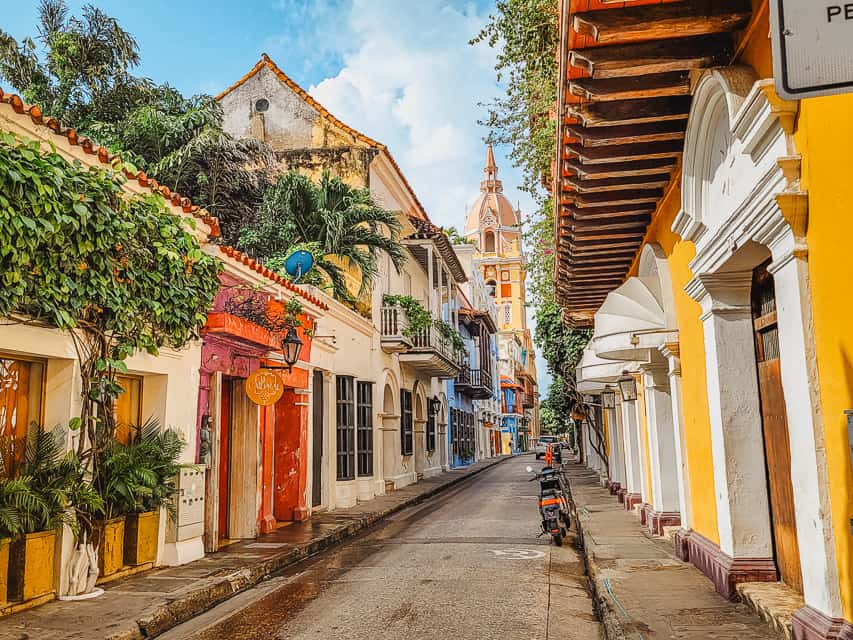
This cathedral is the most famous church in the city and is absolutely a top place to see in Cartagena.
The view down Calle de la Iglesia (Carrera 4) leading up to the church is one of the most iconic photo spots in Cartagena. In a city full of cute and pretty streets, this street is particularly charming and picture perfect, with numerous plants and brightly colored houses leading up to the church with its distinctive yellow + peach tower rising proudly above the roofs of the city.
Come here earlier in the morning (before 8:30) if you want a picture down this street without tons of people, cars, and trucks in it.

The interior of Catedral de Santa Catalina is so gorgeous! There were black and white tiled floors, grand stone archways leading all the way down the church, an interesting arched wooden ceiling, and a beautiful gold altarpiece.
We did find that it was pretty hit or miss for when the churches were actually open for a visit, but had luck with a lot of the churches being open around 11am, or around 5pm.
9. Iglesia de Santo Domingo

The interior had a beautiful, goldenrod color on the walls, with stone arches extending across the top of the nave of the church. This felt unique because in most churches we visited in Colombia, the arches went along the sides of the nave, not across the top of the middle.
Again, we had luck with this church being open around lunchtime.
10. La Gorda Gertrudis Botero Sculpture

In front of the Iglesia de Santo Domingo is the Plaza de Santo Domingo, a peaceful square during the day that becomes more lively at night.
The focal piece of this square is Gertrudis, the Botero statue on display. Botero is Colombia’s most esteemed artist, and there are museums in Bogota and Medellin devoted solely to his work.
In Cartagena, his main work is just this sculpture (though Botero also paints as well). His sculptures are always done in bronze and in a very recognizable style, with obese subjects.
It is said to be good luck to rub her breasts or bum. Do with that information what you will.
11. Door Knockers

Given that Cartagena is a historic and colonial town, as you walk around the city, you may notice that there is a large variety of interesting, unique, and sometimes funky door knockers around town.
Keep your eyes open for lions, vases, flowers, and lizards on the doors as you stroll the city.
12. Take a Picture with Palenqueras Fruit Ladies

All over Old Town, you will see these women in bright-colored dresses, balancing bowls of fruit on their heads and smiling for a photo-op.
These are the palenqueras ladies. Palenquere is a nearby city and was established by freed slaves. Though free, they were in poverty, so the women would walk into Cartagena, balancing baskets of fruit on their heads to sell.
Today, they do more posing for photos than selling fruit, but they are an iconic part of the city, and taking a picture with these brightly dressed ladies is certainly a fun thing to do in Cartagena.
Here’s a quick Cartagena Travel Tip: If you want a picture, you will either need to buy some fruit or tip the ladies for the photos. Make sure you settle on a price per person before taking any pictures (and if they offer to bring someone else in while you’re taking pictures, be prepared to pay double). If they say they just take tips, 20,000 pesos is a good place to start.
13. Convent of Santa Cruz de la Popa

The Convent of Santa Cruz de la Popa is the highest point in Cartagena and is situated on a hill just outside of the old city.
A patio/balcony encircles almost the entire exterior of the crisply white building, where you get unmatched views over the sea, the old town, Bocagrande, and inland (including the airport! Am I still 5 and love watching the planes take off and land? Yes. Yes I am.).

After enjoying the views, wander inside to the courtyard of the convent. With its archways, brick paths, and abounding greenery, this courtyard is absolutely lovely. Fun fact: The courtyard is actually designed as a water collecting area, as rain will fall in and collect at the well in the center.

Around the perimeter of the building are several different rooms – one is a chapel, one is an artifact room, and one holds dresses for the Virgin of Candelaria holiday/celebration held on February 2 in Cartagena.
A few of the descriptive placards for these exhibits were in English, but most were in Spanish. Some were easy to figure out based on cognates and context. Others we used Google Translate’s photo translation feature to read the paragraph easily.
This might be a spot where you would want to get a taxi – you could walk here, but it is a little farther away from Old Town.
When we went, there were not a lot of people there (which I think is pretty typical), so it was nice and calm and peaceful. This was actually one of my favorite places we visited in Cartagena, so I would definitely prioritize coming here.
- Hours: 8:30am-5:30am
- Price: 13,000 COP
14. Castillo de San Felipe

While called a castle, a more accurate descriptor for this structure may be “fortress”!
The fortress is large and there are several levels and sections to walk around and explore. You can walk up to the top of the ramparts, and see the old cannons and turrets. Or, descend into the fortress and walk along some interior tunnels, which is a kind of fun and immersive experience.

You can also enjoy some nice vistas over the city, though nothing compared to at the Convent.
This might be a good place for a guide – there are almost no signs or placards here, though the two signs we did see did have English translations. If you want any history or context to the fortress, either go with a guided tour group, or hire one of the people offering to be guides at the entrance (remember to haggle for the price if you hire someone on location).
Getting there: While you can take a taxi or go with a group, it is only a 15 minute walk from the north part of the city, so walking is also a very viable option – we even did it one way.
- Hours: 7am-6pm Mon-Sun
- Price: 27,000 COP foreigners, 23,000 COP nationals
15. Learn Salsa Dances with Locals
Cartagena has a lot of great salsa dancing bars, but if you’re a total newbie to Latin dancing (or just need to brush up your skills!) a small group, evening dancing class is a good way to ease into the salsa scene.
In this class experience, you’ll be learning several Latin American dances on the grass-covered, private rooftop terrace of a couple in Getsmani. Your instructors are friendly, fun, and laidback, and overall it’s a really fun way to learn the basics of these beloved Colombian dances.
Check rates and availability for these salsa lessons here
16. San Pedro Claver Sanctuary

Back in the 1600’s, Pedro Claver was a priest who worked tirelessly to minister to the African people enslaved in Cartagena. He baptized many people and worked to ensure they were treated humanely.
He called himself the “slave to the slaves” and was a very highly revered man. He was canonized in the 1800’s as the patron saint of slaves. This cathedral is dedicated to his name, and his relics are entombed in the altar.

This church had tiled floors, trefoil arches, and a dome over the altar area. It was a pretty church to visit!
You can also visit the sanctuary museum next door, which has some exhibits about the history of San Pedro, as well as paintings and sculptures.
While the church was often closed, we had luck with this church opening around 5pm.
17. Las Bovedas Market

“Las bovedas” means “the vaults,” which are present in between the long archway stretching along the city wall. While it was constructed as a spot to store munitions and other military supplies, it eventually was used as a dungeon!
Today, Las Bovedas is a market, with over 20 individual stores in each of the “vaults.” There are also some vendors set up selling goods on the sidewalk as well.


You will find souvenir-type goods here, and while there is definitely variety between the stores, there is a lot of overlap as well. Types of goods for sale include bags, purses, plates and bowls, art, jewelry, t-shirts, trinkets, dresses, and hammocks. There are also a few more art-based, handmade stores.
Shop around and get prices from a few different vendors – you may be able to haggle a bit here! I will say there were generally somewhat better prices at Las Bovedas than you would find on the street in the rest of the city.
18. Portal de Los Dulces

The covered passageway along the south edge of Plaza de Los Cloches has around 15 candy stands, carrying traditional Colombian candies. There is some variety between the stalls, but they generally sell the same type of treats.
We were able to sample 3 unique types of treats:
Coconut candies: This includes smaller chocolate coconut balls, or larger coconut clusters in a variety of flavors (e.g. guava coconut clusters, or arequipe coconut clusters)

Tamarind Balls: These tamarind balls are chewy and are rolled in sugar, and came in either small or large sizes. The tamarind has a strong and distinctive taste. It wasn’t bad, but it was very different!
Milk Wheels: These traditional cookies hold together like shortbread but are soft. We didn’t think they tasted great… kind of like a molasses or old-time chewy candy that is milk and sugar based, but obviously they were popular locally.
This is a really fun place to sample some treats in your Cartagena itinerary you may have never tasted before, and are traditional to Colombia.
19. Museo del Oro Zenu (Gold Museum)

The gold museum is split into two main exhibits. The first exhibit focuses on the slave trade in Colombia and Cartagena specifically, and the role of the slaves in mining for gold.
The rest of the museum had display cases with many different types of gold figures, bowls, ornaments, decorations, breastplates, earrings, nose rings, and necklaces used by indigenous tribes all around the country – with the largest area focusing on the prolific Zenu tribes.
There are placards along each display case talking about what the different gold objects were used for, some of the history of the tribe, and how they worked the metal.
We went to the Gold Museums in Bogota and in Cartagena. The Bogota museum was very impressive and had thousands and thousands of gold pieces on display.
However, we actually felt like the Cartagena museum, though much, much smaller, was actually more interesting and accessible, solely because there were English translations for every single paragraph or note on the placards or displays.
It’s free and a very interesting thing to do in Cartagena, so I would for sure recommend a stop.
- Hours: 8:30am-5pm Mon-Fri, 9am-1pm Sat
- Price: Free
20. Santa Toribio Church

The Iglesia de Santa Toribio was the smallest of the 4 churches we visited in Cartagena, but it was still a beauty! The Santa Toribio church had an intricate tiled floor, and white walls contrasted with a dark stained ceiling.
21. Abaco Libros Y Cafe

Book lovers, this one’s for you! The Abacos Bookstore and Cafe is just that, an adorable and incredibly aesthetically pleasing bookstore that melds around a coffee shop. Order a drink and a slice of cake and then peruse the selection of books in Spanish.
There was a selection of books written by Colombian and South American authors, but then also a large collection of popular books from the US that had been translated into Spanish as well. Super cute and super charming.
22. Palace of the Inquisition

This “palace” is actually a museum that focuses on the history of the Inquisition in Cartagena specifically, and the Americas, more generally. Each room had at least one explanatory placard in English, but be aware that many of the artifacts and other displays were only in Spanish. It was an interesting look at what happened and what prompted the Inquisition.
The upstairs section of the museum focuses on the history of Cartagena and how it came to be founded and developed.
While we did not spend a ton of time here, it was an interesting and quick museum. (Plus, the courtyard was really pretty!)
- Hours: 9am-6pm Mon-Sat, 10am-4pm Sundays and holidays
- Price: 23,000 pesos (about $5) per adult
23. Go on a Sunset Cruise


This was one of my favorite things to do in Cartagena because you get to experience the city from the water! This 2 hour catamaran cruise leaves about an hour before sunset from the docks just steps from the Torre del Reloj gate.
The boat takes you out of the harbor, past the high rises of Bocagrande and the shipping port (where you may see shipping containers being loaded or unloaded from cargo ships), and into open water where you have a clear view of the western setting sun.
The breeze feels lovely, and even though sunset was somewhat obscured behind clouds for us, we still had a great time and enjoyed watching the sun sink lower and closer to the horizon on the sea.
The catamaran itself is set up great for this type of cruise – there are a lot of benches to sit and spread out, plus nets set up over the water to relax on. Salsa music is playing, you get a free drink (alcoholic or non-alcoholic) from the bar, and a snack is provided.
Check rates and availability here
24. Hit the Beach

One of the absolute best things to do in Cartagena is to actually leave the city and head to the nearby islands for gorgeous tropical beaches. The beaches right near the Old Town are… not great—certainly not the tropical paradise you would imagine when you hear the term “Caribbean beach.”
Thankfully, the beach of Playa Blanca on Isla Baru is one of the most beautiful and easily accessible beaches in the area, with soft sand and glittering turquoise water.
25. Soak in the El Totumo Mud Volcano

This is a really quirky and unique attraction outside of Cartagena to El Totumo, an active mud volcano. The “volcano” itself is quite small, and you can walk up to the top and get covered in the mud, which is said to have healing properties. Also, the mud is buoyant so you don’t sink to the bottom.
There are people there who will give you a massage, take pictures of you with your phone, and help rinse you off afterwards (bring some small change to tip anyone who helps you). Definitely wear a swimsuit and clothes that you don’t mind getting really dirty (or even discolored) from the mud.
Since the mud volcano is about 1.5 hours from Cartagena, you have 3 options for how to get there. First, take a cab. Second, rent a car and drive yourself. Third, go with a tour.
If you decide to go with a tour, I would absolutely do this tour with an early morning departure time, specifically to avoid the vast majority of other visitors and tour groups. Additionally, on this tour you will make a stop at the Galerazamba salt flats, which is a pink lake! (Depending on weather and season conditions)
Check rates and availability here





